A newly discovered mushroom species in the southwestern region of China is particularly “greedy,” with its primary “food” sources being resin and rubber. Scientists hope to utilize these mushrooms for better plastic recycling.
Biodiversity Region with Hundreds of Thousands of Mushroom Species
Yunnan Province in southwestern China has been identified as a habitat for many strange mushroom species. South African mycologist Peter Mortimer has studied Yunnan mushrooms for over 10 years at the Kunming Institute of Botany. He states that some species of mushrooms could help address the planet’s plastic and rubber waste issues.
“Yunnan has a vast array of landscapes and climates in a small area, ranging from lowland tropical forests in the south to high mountains in the north. Yunnan is also home to many mountains, which create a diverse landscape with different types of forests and soils, leading to a great variety of mushroom habitats.”
Although 6,000 mushroom species have been discovered in Yunnan, “this is likely just a very small part of the total number of species in this province.” Scientists estimate that Yunnan may have nearly 100,000 undiscovered species. Worldwide, scientists have identified about 140,000 mushroom species.
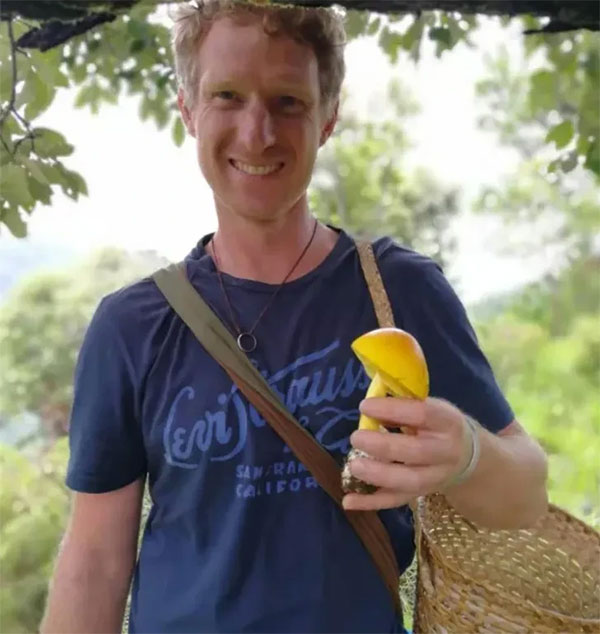
Peter Mortimer holding a new mushroom species during a collection expedition in the Mekong River region, Yunnan Province.
Last year, Mortimer, along with Samantha Karunarathna from Qujing Normal University in Yunnan, discovered several new species with a special ability: “they can ‘digest’ both plastics and latex, or natural rubber made from tree sap.” These newly discovered mushroom species could be key to new green technologies for recycling plastic and rubber waste. Mortimer also has a hunch that the southern tropical region of the province may have rubber-eating mushrooms.
“We went to a rubber plantation in Xishuangbanna to look for mushrooms. Mortimer mentioned that there was an old plastic bag discarded in the bushes, and mushrooms were growing on it, digesting it.” Among the species found on the plastic bag, four new species had never been seen before. “We found many new species. But the mushroom on the plastic bag was discovered to have four unrelated new species, all capable of degrading plastic – that was a good finding.” Particularly, they were also excited by another surprise: all four of these new mushroom species could digest tree sap in the laboratory.
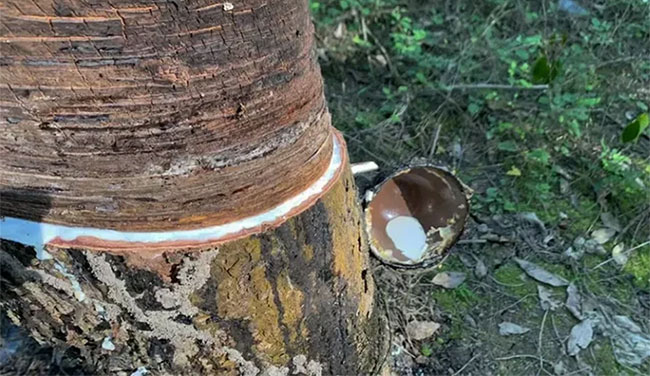
A rubber tree with white latex residue and a cup in Xishuangbanna, Yunnan Province.
The newly discovered Yunnan mushrooms promise excellent capabilities for degrading both latex and plastic. Mortimer stated: “Mushrooms capable of degrading plastic have been known for many years, but this is the first time we have discovered mushrooms that can degrade rubber latex. And this is certainly the first mushroom species with dual effects, capable of degrading both latex and plastic.”
Latex, also known as natural rubber, is a widely used material, superior to synthetic rubber in many applications, including tires. By consuming plastics or rubber, mushrooms can transform these materials into other biomass. “It looks like white cotton, smells like a damp forest. Then, it can be used to make fertilizers, animal feed, building materials, biofoams, and packaging.”
Mortimer and his team have fed their mushrooms various types of plastics. “Polyurethane – PU – is the most biodegradable material, and that is what we are focusing on.” The world is choking under a pile of plastic waste, with nearly 300 million tons produced annually. Plastics made from polyurethane, used to manufacture foams, fibers, and tires, account for 8 million tons. Polyurethane is difficult to recycle, with 90% of it ending up in landfills. Even when processed, polyurethane releases harmful pollutants.
Mushroom species capable of degrading polyurethane in the laboratory have been known for nearly 20 years. Practical applications of plastic-eating mushrooms for polyurethane waste have been discussed by researchers for over a decade. Recycling experts say that if the technique using natural mushrooms succeeds, it could replace costly and unsanitary recycling processes similar to composting.
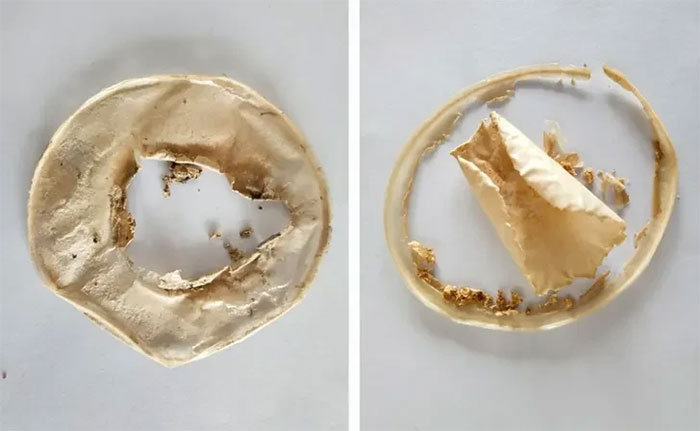
Partially digested polyurethane film on the left and completely digested on the right in the laboratory by plastic-eating mushrooms discovered by Mortimer’s team.
Nicole Pei, a waste management engineer (founder of Cair Technologies, a Hong Kong company specializing in providing biological systems for controlling emissions from wastewater treatment processes) stated: “Biological recycling has proven to be the most cost-effective method for managing waste and wastewater. Currently, plastics are either landfilled or subjected to thermal treatment, and thermal processing of chlorine-containing plastics can produce dioxins, with the use of fuel to generate sufficient heat being very costly.”
However, the mushroom species discovered so far are believed to be not fast enough to digest plastics. Will the newly found Yunnan mushrooms make a difference? Mortimer emphasizes that his research is just beginning but mentions that the results have shown much promise – the mushroom species found on the plastic bags in Xishuangbanna are strong PU feeders.
Mortimer stated: “I am very excited – these four new species are aggressively attacking PU, showing a very high degradation rate.” However, the ability of similar mushroom species to consume tree sap still requires further assessment. “We are at a very early stage of the process. In the laboratory, these mushrooms obtain nutrients from the sap, but we have not yet tested the rate of loss and degradation of the sap’s mass.”
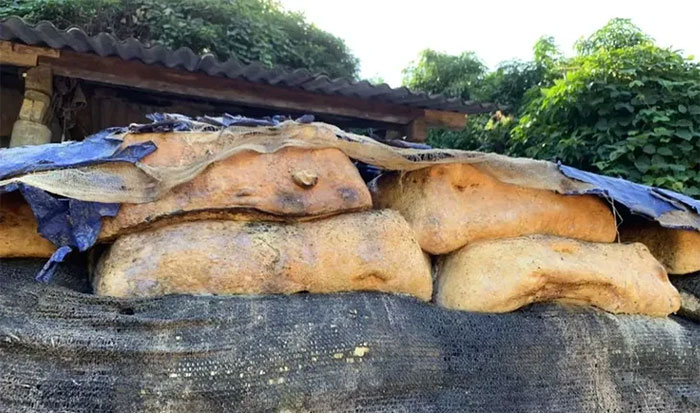
Processed latex sheets stored in a rubber plantation in Xishuangbanna, Yunnan Province.
The Mushroom’s Special “Weapon”
What allows mushrooms to “eat” difficult-to-digest materials like plastics? Mortimer explains that mushrooms possess specialized enzymes that no other organisms have. These enzymes can break down the strong bonds in chemical compounds, such as lignin and cellulose – substances that are difficult to digest for most living organisms. This characteristic also allows some mushroom species to digest wood.
However, Mortimer explains that mushrooms do not just have one type of such enzyme, but rather “a whole arsenal of them; a cocktail of enzymes that allows mushrooms to adapt and benefit from different environments”… One thing that Mortimer and researchers are still pondering and seeking answers to is whether the ability to degrade plastics and latex is merely a “fluke” of nature or the result of an evolutionary process. He explains that an enzyme developed to break down wood could also cut molecules like polyurethane. Additionally, the ability to consume plastics and latex may be a result of the mushrooms’ evolutionary process to exploit the resources of our polluted world.
Mortimer is currently researching the plastic- and latex-cutting enzymes of mushrooms and the genes encoding them. If they are different, it could suggest that “this ability has been developed independently by different mushroom species, showing that mushrooms are adapting to their environment.”
Mortimer adds: “We also found a range of other mushroom species living directly on rubber latex in the plantation. Studies are ongoing, but their characteristics and sequences have not yet been officially identified.”
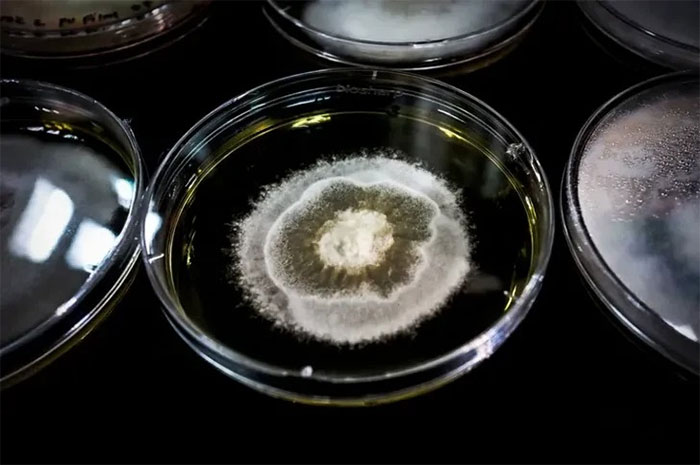
Cultivating plastic-eating mushrooms in Peter Mortimer’s laboratory, Kunming, Yunnan Province.
Many Other “Recycling” Mushroom Species May Exist in Yunnan
To achieve industrial-scale recycling, the mushroom species Mortimer observed in the petri dish must be transferred to a bioreactor. “It sounds like a huge and impressive thing, but a bioreactor is nothing more than a steel tank where you maintain the perfect conditions to keep the mushrooms thriving.” Mortimer stated: “Bioreactors are very simple, but they can be expensive to operate and build.” He is currently seeking funding.
“Our next step is to set up and operate bioreactors. We will attempt to calculate the different degradation rates at different volumes of plastic and mushrooms, as well as test various growing conditions to see what makes the mushrooms thrive the best. In one or two years, we will have our own bioreactors to test this.”
Mortimer then plans to patent methods for degrading plastics using mushrooms in bioreactors. He already holds a patent for the first plastic-eating mushroom of the Aspergillus genus that his team discovered in Yunnan.
“In 2022, we were granted a patent, at the petri dish level, for the preparation processes of plastics, to expose them to some form of treatment – such as ultraviolet light to help degrade them before allowing the mushrooms to grow directly on them.”
Mortimer explained: “New species are proving to be more effective, and at the level of bioreactors, there will be different patents due to varying cultivation conditions. Each species of mushroom or a cocktail of species can be a separate patent. Additionally, when we engage with different types of plastics, a range of patents will follow.
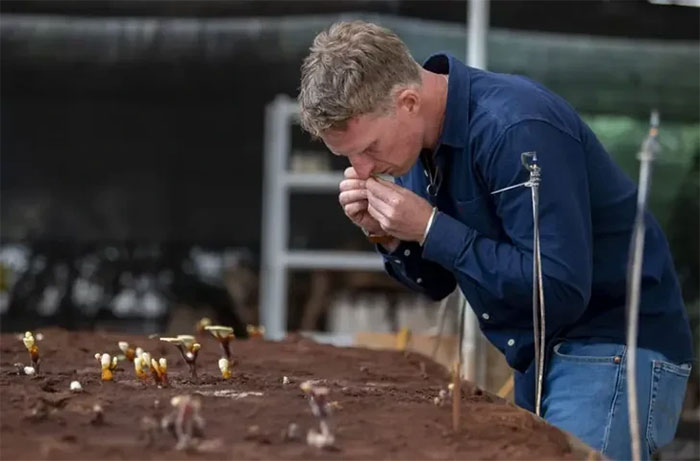
Peter Mortimer examines mushrooms in his laboratory in Kunming, Yunnan Province.
The species of mushrooms that Mortimer’s team has discovered show promising potential, and the search for more types of mushrooms is ongoing. He also mentioned that to recycle industrial mushroom-based plastics that can be marketed, the mushrooms used must be “chilled out” and have the “right chemical arsenal”. The concept of “chilled out” refers to the acceptance of their habitat, meaning they will not be picky about their conditions in the bioreactor. “They must be comfortable in a general environment, where you don’t have high energy costs to maintain specific levels of temperature, oxygen, and carbon dioxide,” he stated. The “chemical arsenal” refers to the enzymes present in the mushrooms.
Mortimer also hopes to find mushroom species that can break down tougher plastics. “Mushrooms need to have the weapons, enzymes to break down not just polyurethane, because with polyurethane, we are competing with a very large recycling industry. But if we start breaking down stronger plastics like polyvinyl, then we could really stand out.”
For this reason, Mortimer stated that scientists will need more than one “chilled out” mushroom species. “To have the ultimate solution in a bioreactor, we need such a mushroom, with different enzymes to digest different types of plastics.” He added that “Looking further into the future, I could also see a spray made from mushroom enzymes that could be applied to plastics.”
Moreover, Mortimer explained that mushrooms could provide a way to recycle melted plastics that cannot be recycled by current methods. “Conventional recycling is ineffective for things like spandex integrated into your jeans and Tetra Pak with aluminum lining inside. Potentially, a type of mushroom could grow on such waste and selectively digest the different components in those composite systems.”
Can mushrooms live up to this potential and provide a green plastic waste recycling solution? This is entirely possible if we find the right type of mushroom. “The issue is the timeframe in which mushroom species with the right chemical arsenal will naturally emerge. Statistically, they are likely in Yunnan.”


















































